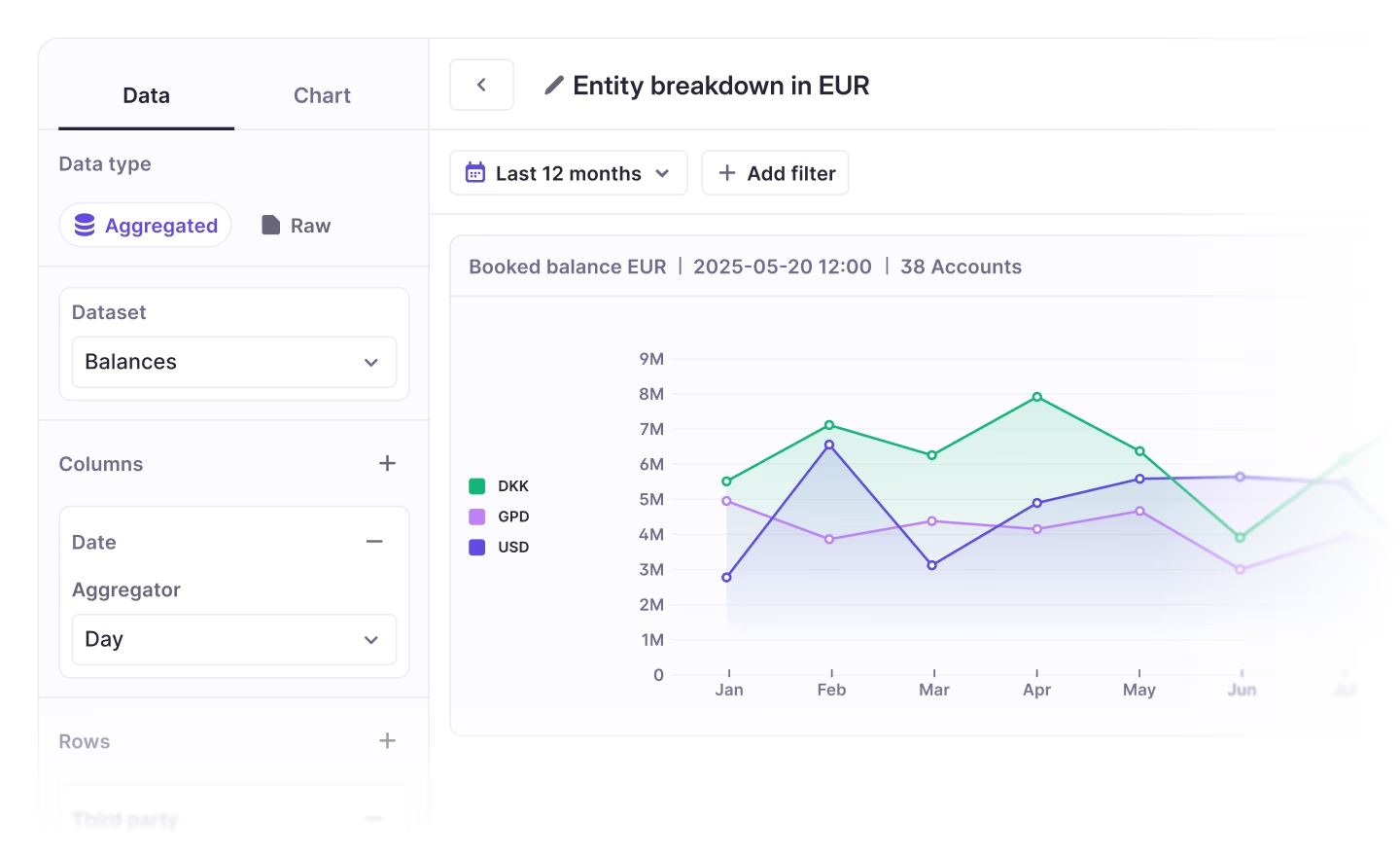What is a Treasury Management System (TMS)?
A treasury management system (TMS) is a platform that companies use to manage their cash positions, coordinate financial operations, and reduce financial risk.

Introduction to treasury management systems
The first treasury management system (TMS) was released in the 1980s as a standalone machine that literally sat in the corner of the treasury department. Today, a well-implemented treasury management system can still act as the command center of your finance stack, though most are cloud-based and delivered through a software-as-a-service (SaaS) model.
The purpose of a TMS is to streamline and optimize the management of your financial operations. From cash management to risk management, liquidity management to compliance, it plays a central role in ensuring your treasury functions and is managed efficiently. At the most basic level, it works by aggregating and normalizing financial data from multiple sources, such as your bank accounts, and enabling certain actions to be taken off the back of that data.
For a more detailed exploration of TMS functionality and the different options available, read our guide to choosing the right treasury management system.
How does a TMS work?
Your treasury management system works by connecting external and internal systems, such as banks and ERPs into a single system. Most systems are designed to connect directly to banks through established channels such as host-to-host, EBICS, and Swift. The TMS then aggregates data from these various sources and presents it in a standardized format. In this way, you can view account balances, financial transactions and expected cash flow across the entire business, simplifying your reporting and cash forecasting and informing strategic decisions.
A good TMS is not a read-only tool. It can also automate and schedule payments, making it easier to handle large transaction volumes. Many systems also enable you to manage deals and contracts relating to loans, investments, FX hedging, and more. A fully-fledged TMS will also support you with risk management, such as by helping you to track your exposure to interest rate and currency fluctuations.
Typically, TMS functionality is delivered through modules which are installed and configured separately. Most systems receive and process data every 24 to 48 hours.

Benefits of a TMS
Automation
A good TMS will remove the bulk of manual tasks from your finance teams, freeing them up to focus on more strategic activities. You won’t need hours of manual work wrestling with multiple tools and data sources to understand your cash position. Instead, you can use your TMS to quickly generate a real-time snapshot of your financial health.
Your TMS can also be used to automate and schedule your payments via preset controls and permissions. This ensures you have total control over your payments while also reducing the risk of human error.
Simplified reporting and reconciliation
TMS software comes with reporting tools to help you easily create and share financial reports, improving transparency and collaboration while eliminating errors from manual data entry. Reconciliation can be complicated, especially if spread across spreadsheets, emails, and bank statements. A good TMS will do the heavy-lifting for you. Even as your payment volume increases, you’ll be able to reconcile payments without requiring large teams.
Cost efficiencies
Particularly for larger companies, a TMS can help reduce the costs associated with manual processes, inefficiencies, errors, and fraud. It will also help you save money by giving you the visibility to optimize your cash flow, and minimizing borrowing costs. Given the relatively high costs associated with purchasing, implementing, and maintaining a TMS, these cost efficiencies typically apply only to companies that have reached a certain scale.
The functions of a TMS
Your TMS has an important job to do. Here’s a breakdown of its key functions.
Connectivity
Your TMS functionality is underpinned by its ability to connect directly to banks or other financial institutions through traditional, file-based channels such as host-to-host. Modern platforms, like Atlar, can also support connections with API-first platforms, like modern banks and payment platforms.
Liquidity management
A TMS provides a single overview of your liquidity across multiple accounts and currencies. This enables your treasury teams to forecast cash flows and optimize your working capital.
Payment processing
Your TMS can automate the initiation, execution, and reconciliation of payments, including wire transfers and ACH transactions. By centralizing your payment processes your TMS will enhance your efficiency, reduce errors, and improve overall cash flow management.
Cash forecasting
A good TMS will be able to leverage historical cash flow data, ERP data, and manual inputs to generate accurate cash flow forecasts. These will help inform your decisions around investment, borrowing, and risk mitigation strategies.
Risk management
With its real-time risk analysis and scenario modeling capabilities, a good TMS will help you proactively manage your exposure to financial, market, credit, liquidity and operational risk.
Debt and investment management
Your TMS plays a key role in debt management by providing a centralized platform to store and manage information related to your loans, bonds, and other lines of credit. It will also help you optimize your investment strategies. Real-time reporting and analytics allow you to monitor your investment performance and ensure you get the most from your portfolio.
Financial reporting
Reporting is a central component of your TMS. By aggregating financial data from banks and other sources into one standardized view, it makes it easy to access and analyize reports in a range of formats.
Compliance
By centralizing the management of cash flow, payments, and financial risks, your TMS allows you to implement robust security measures and create internal controls to ensure you comply with regulatory requirements across various markets.
Data security
TMS software includes vital security features, such as encryption during data transit and when it’s at rest, role-based access controls, and audit trails.
Deal management
Some TMS offer features to manage deals and contracts relating to loans, investments, and FX hedging, either directly or through third-party services.
Multi-currency support
A TMS can typically handle multiple currencies, making it easier to manage conversion rates and currency risk.
TMS delivery models
Treasury software is typically delivered in one of three ways:
- Local installation: This is the most traditional method, where your TMS is installed locally on your company’s servers and maintained by your IT team.
- Hosted service: In this case, your TMS is provided by a single-tentent environment and connectivity and data is managed in-house.
- SaaS: Your TMS is accessed through a browser with the provider managing support, upgrades, and connectivity.
Our guide to choosing a TMS goes into more detail on each of these software delivery models.

Key considerations when implementing a new TMS
As the cornerstone of your treasury function it’s important to ensure the roll-out of a new TMS runs smoothly. Here are some things to bear in mind.
- Scope: Functional requirements, technical requirements, and integration needs.
- Implementation: Project timeline, milestones, resource requirements, and budgetary considerations.
- Data migration: Data must be cleansed and validated to ensure accuracy, completeness, and integrity when migrating from your legacy system.
- Training: Comprehensive training of all system users to ensure smooth adoption.
- Change management: To promote user acceptance.
- Integration: Consider how the new TMS platform will integrate with existing systems and applications.
- Testing: Validate system functionality, performance, and security before going live.
How Atlar can help
Modern treasury platforms like Atlar combine the core functionality of a TMS with modern API connectivity, real-time reporting, and user-friendly tools. Quicker to implement and easier to use than a TMS, Atlar is aimed at businesses that use several or more banks but have a limited budget for tooling and IT support.
It takes 4-6 weeks to implement Atlar on average – compared to up to 18 months for a TMS. And unlike legacy TMS interfaces, Atlar is designed with UX principles and ease of use in mind. This helps to make even advanced features like forecasting more readily usable.
Atlar provides customers like Acne Studios, GetYourGuide, and Forto with a single platform that connects to everywhere and gets you up and running in weeks. Finance teams are now better equipped to do the work that keeps our businesses running, saving hours on admin tasks and managing money more efficiently. To learn about why modern finance teams choose Atlar and see some case studies, head over to our customers page.
You can unsubscribe anytime.
Further reading
See Atlar in action.
Enter your work email to watch a live product demo.


